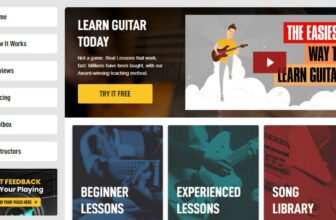How Long Does it Take to Learn Guitar?

Learning the guitar is a process that will vary depending on the individual. This includes how much you practice, how committed you are, and if you enjoy it. You can achieve beginner level in just 2 months. Intermediate playing can take around 6-12 months. Advanced-intermediate will be over 1 year.
The process of learning the guitar is solely based on the individual. Not everyone can sit and practice 5-6 hours a day. It also depends on if you want to learn music theory and expand your knowledge of all things music. Many factors come into play.
Today, I’ll focus on the general idea and the rough estimate of how long it takes to learn guitar and get to an intermediate-advanced level.
Contents
How Long Does it Take to Learn Guitar – At a Glance
| Skill Level | Time | Summary |
Beginner | 2 – 6 months | Knows basic chords, can hold a tune, not perfect technique, can play basic songs, and starting music theory. |
Intermediate | 6 – 12 months | Fairly good knowledge of chords, can play the majority of songs, starting to feel at ease with the guitar, and starts to grasp music theory. |
Advanced-Intermediate | 12 – 24 months | Great chord knowledge, improvising, music theory is almost perfect, great technique, and the guitar starts to feel natural. |
Advanced | 24+ months | Advanced chord knowledge, improvises easy, music theory is done, the technique is perfect, and somewhat mastery over the instrument. |
This is by no means a definitive timeline. As I previously mentioned, it depends on the individual, that is why the time frames are stretched out.
Practice Hours and Time Estimate
A beginner guitarist is considered to know basic chords, can hold a tune with a sloppy-to-somewhat-decent technique, knows a few basic songs, and starts to learn music theory. Depending on your dedication, if you practice more than 1 hour, even 2, you can achieve this level in just 2 – 3 months.
An intermediate level can be achieved in a rough estimate of 6 – 12 months. This also depends on the hours you put in. Practicing 2+ hours a day will lead to achieving this level in just 6-8 months. You can play chords easily, learn a few more difficult songs, the guitar starts to feel more natural, and you start to grasp music theory.
Advanced-Intermediate level is a tricky one, to say the least. That is why the gap is 1 to 2 years, in general. If you have the passion and start practicing 2, even 3+ hours daily, this can be done in just a year and a half. You will start improvising on the guitar, your technique will feel almost perfect, and your knowledge of music theory should be about done.
Advanced level is a huge concept, but, for the sake of the article, I won’t go into the many levels of advanced players. Advanced playing is having perfect technique, chord knowledge, easy improvising, and knowing music theory. Assuming you’ve been practicing more than 2 hours every day, 2 years in, or more, you will attain this level of mastery.
How to start learning the right way?

Many factors come into play on how to approach learning the guitar. Firstly, you should opt for the best option which is an acoustic guitar, preferably with nylon strings. Secondly, practice will determine how fast you progress. Additionally, you’d want to develop your calluses as quickly as possible, but not overdo it and risk an injury.
Thirdly, learn the fundamentals which are holding notes, learning scales, playing basic songs, and learning chords. Lastly, try some guitar lessons, private or online, to narrow down the learning process and progress more efficiently.
1. Choose your weapon
The best way to learn is by buying an acoustic guitar, preferably with nylon strings. Nylon strings will be more suitable for not-yet-developed/hardened fingers. There is a reason why an acoustic guitar with nylon strings is the ideal beginner’s weapon. You minimize injury while learning the basics like holding a guitar, fretting, and producing your first sounds.
While it’s fairly doable to jump straight onto an electric guitar, gradually progressing is a well-known and effective method. Start with an acoustic guitar, learn the basics, and sometime in the future, get yourself an electric one.
2. It’s all about practice
It all boils down to practice! Your practice hours will determine how and how much you progress. Developing a healthy habit of everyday practice will pay out in the long run. But, be mindful that beginner guitar players might risk injuries if they don’t practice accordingly and correctly. Starting and practicing more than 2-3 hours a day will do more damage than good.
Developing calluses is a vital process. You want to gradually build up/harden the finger skin without injuring your fingers. Start with 30 minutes and slowly progress to 1 hour to effectively develop calluses. After a while, try changing the nylon strings to metal strings to further harden the skin.
To learn about developing calluses the right way, you should read up on everything you need to know about them, how to develop them, how to treat injuries, and more.
3. Start with the fundamentals
It’s easy to get carried away and want to learn advanced stuff, but this can be counterproductive and may even discourage you. Start with the crucial fundamentals! Learn how to properly hold a note, learn some chords, and start practicing your scales, then you can try learning some beginner acoustic guitar songs.
Gradually progressing is a far more effective method. Learning the basics is a vital component of building your foundation as a guitarist. Without them, you will never progress the way you want to. Stick to the basics and progress will come sooner rather than later.
4. Guitar lessons
Not everyone is self-taught, and there is a reason why guitar lessons even exist. Learning the correct way in a more narrow-type approach is a proven winning method. A guitar tutor can effectively build your fundamentals and lay the groundwork for your future progress.
He or she will also advise on how much you should practice and be more effective. Gradual progression is a must when learning with a guitar teacher. But, it has many benefits that will pay out in the long run.
Investing in such a process is money well-spent, especially in a time where quality online guitar lessons are widely available.
Is learning the Guitar hard?

A few comforting words, in a way, are that the guitar is a fairly easy instrument to learn but a hard one to fully master. This is true in every sense, but it still boils down to how much your practice and how devoted you are.
The guitar is a simple instrument to grasp when starting. Getting to a beginner stage is fairly easy with moderate practice. Naturally, once you start to progress you will want to learn more and become even more proficient. This is where things get tricky and the practice sessions will determine the outcome.
Age is not a determining factor in this question. Granted, starting early is always better but it is never too late to learn the guitar. Adults might even have the edge since they are more organized and more serious about their endeavors.
Which Guitar is best suited for beginners?
Knowing which guitar to start with is an often overlooked but vital element. Arguably, the acoustic guitar is the easiest and most effective way to go. You can check out this subject matter in more detail if you want on our article “What is The Easiest Guitar to Play for Beginners?“.
There are a lot of affordable acoustic guitars out there, but I recommend you check out the Fender CD-60S. This is the ideal guitar that will serve you at the beginning and stick around deep into your guitar experience. Investing in the right guitar is very worth it!
One thing to keep in mind, when looking for a good beginner guitar, is the neck length. The length of the neck plays a big role in the playability and comfort you have on the guitar. Naturally, a 38-inch neck is better suited for beginners than a 41-inch neck. To be safe, visit your local music store and try out a 38-inch and a 41-inch guitar to see which one suits you more.
What are some useful guitar accessories to have?
When it comes to completing your gear with accessories that will be useful, you have a few things to consider. Firstly, of all the guitar parts, you should pay close attention to the strings. Strings are of the utmost importance. There are also accessories like a tuner, case, slide, humidifier, guitar stool, and a finger strengthener.
- Tuner. A tuner is the first thing you should buy. Tuning your guitar before playing is a great habit that will aid the longevity of your strings and sound. There are great free guitar tuner apps available today.
- Strings. Strings will play a huge role in the sound, as well as the comfort with which you play. Nylon strings for beginners are recommended. Also, have a spare set for when you need to change the strings
- Case. Buying a case will be the best thing you can do. Preserving your guitar and strings will aid in the longevity of the instrument while also keeping the sound intact. Proper storage is often overlooked, but it can make or break your instrument.
- Slide. A guitar slide is a useful little addition that will produce some beautiful tones. Having one around will spice up your playing while keeping it entertaining. It’s a cool little accessory to have within reach.
- Humidifier. Going back to proper storage, guitar humidifiers aid in balancing humidity levels within your guitar case. Humid temperatures affect the guitar in many ways and can even lead to permanent damage. Consider buying one.
- Guitar Stool. Posture and comfort are key elements to keep in mind when playing guitar. A guitar stool is a great investment to improve the quality of your practice sessions while preventing injuries or back problems.
- Finger Strengthener. Finger strengtheners are great little exercise tools that will improve your finger muscles. With endurance, agility, and coordination in mind, finger strengtheners are extremely beneficial.
Conclusion
Learning the guitar takes time, practice, and patience. However, it is a very rewarding experience that can last a lifetime. With the right attitude and approach, anybody can learn to play the guitar regardless of age.
To get started, I recommend choosing an acoustic guitar (the Fender CD-60S is a great option) and investing in some useful accessories. Don’t forget to also focus on proper posture and finger exercises to prevent injuries.
Achieving beginner level will take 2 – 6 months. An intermediate level can be reached in 6 – 12 months with a more serious approach to practice. After a year or so of regular playing, you will develop your style and technique and reach an advanced-intermediate level.
Reaching an advanced level will depend entirely on your motivation and dedication to the instrument. With the right attitude, you can be an advanced guitar player in 2 years.






